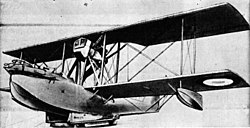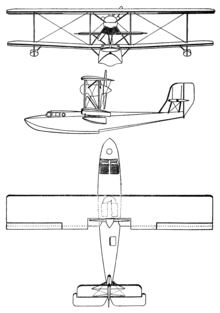CAMS 37
| CAMS 37 | |
|---|---|

|
|
| Type: | Flying boat and amphibious aircraft |
| Design country: | |
| Manufacturer: | |
| First flight: |
1926 |
| Production time: |
1926-1942 |
| Number of pieces: |
332 |
The CAMS 37 was a flying boat and amphibious aircraft manufactured by Chantiers Aéro-Maritimes de la Seine in France in the mid-1920s . The biplane was originally developed as a military maritime reconnaissance aircraft , but was then also manufactured in different versions for civil aviation.
history
It was the first design by Maurice Hurel , who was the new chief designer at CAMS. The prototype made its first flight in early 1926 and was presented at the Paris Air Show that same year . The first production version with an open cockpit was the amphibious version CAMS 37A, which was bought by the French Navy and the Portuguese government. 185 of the 37A alone were delivered.
The CAMS 37 was a conventional double-decker flying boat and its design was very similar to the previous CAMS designs. The CAMS 37 were powered by a W engine , a reciprocating piston engine with three rows of cylinders from the Lorraine 12Ed series with an output of 331 kW (450 hp) and a pusher propeller. The motor nacelle was mounted on struts between the lower and upper wing. The 37 was manufactured in both wood and all-metal versions.
A total of around 340 of the 37 series were manufactured at CAMS.
Outside Europe, the type CAMS 37/11 trainer was in use, in Tahiti until January 15, 1941 and in Indochina until 1942. 110 units of the 37/11 series were produced. The CAMS 37 was also one of the oldest flying boats to be used during World War II .
variants
- CAMS 37, prototype (1 copy)
- CAMS 37A, amphibious version (retractable landing gear for land use) (185 built)
- CAMS 37/2, (also known as 37E) a pure flying boat version with modifications from the 37A series (45 built)
- CAMS 37A / 3, reinforced hull (2 built)
- CAMS 37A / 6, closed cabin, transport version for the French Navy (3 built)
- CAMS 37A / 7, (also known as 37Lia) amphibian / liaison aircraft (36 built)
- CAMS 37A / 9, with metal hull, as an officer's transport flying boat for the French Navy
- CAMS 37/10, version for catapult launch of ships (2 built)
- CAMS 37/11, trainer version (110 builds)
- CAMS 37/12, civil version with closed four-seater cabin (1 built)
- CAMS 37/13, (also called CAMS 37bis) with metal hull version for catapult launch of ships
- CAMS 37GR (Grand Raid), long-range version (1 built)
Technical specifications
| Parameter | Data (CAMS 37/2) | Data (CAMS 37/6) |
|---|---|---|
| crew | 3 | |
| length | 11.43 m | 11.37 m |
| span | 14.50 m (top and bottom) | |
| height | 4.20 m | |
| Wing area | 59.9 m² | |
| Wing loading | 50 kg / m² | |
| Power load | 6.7 kg / hp | |
| Area performance | 7.5 hp / m² | |
| Preparation mass | 2170 kg | 2150 kg |
| Takeoff mass | normal 3000 kg maximum 3125 kg |
|
| Engine | 1 × twelve-cylinder - W motor Lorraine 12Ed | |
| Starting power rated power |
500 PS (368 kW) 450 PS (331 kW) |
|
| Fuel volume | 420 kg | |
| Top speed | 175 km / h at an altitude of 1000 m | 185 km / h at an altitude of 1000 m |
| Landing speed | 85 km / h | |
| Rise time | 8 min at 1000 m altitude 19 min at 2000 m altitude |
6.5 min at 1000 m altitude 13 min at 2000 m altitude |
| Range | 1200 km | 850 km |
| Service ceiling | 3400 m | 3800 m |
| Flight duration | 6 h | |
| Armament | One twin machine gun each in the fore and aft stand | |
| Drop ammunition | 125 kg | 210 kg |
Others
The CAMS 37/10 became known worldwide through the catapult launches at sea from the transatlantic liner SS Île de France on August 23, 1928. Another well-known action of the aircraft was the long-distance test flight by the works pilot René Guilbaud, which covered a distance of 22,600 km in 38 sections without incident covered between the Mediterranean and Africa in 1927.
literature
- The Illustrated Encyclopedia of Aircraft (Part Work 1982-1985). Orbis Publishing.
- Green, William (1968). Warplanes of the Second World War, Volume Five, Flying Boats. London: Macdonald. Pp. 15-17. ISBN 978-0-356-01449-4 .
- Taylor, Michael JH (1989). Jane's Encyclopedia of Aviation. London: Studio Editions. P. 226
Web links
- Photo of a CAMS 37 mounted on an aircraft catapult
- Photo of a CAMS 37 with German registration as a captured aircraft Second World War
- Photo CAMS 37 versions of civil aviation
Individual evidence
- ↑ a b Werner von Langsdorff : Handbuch der Luftfahrt . Born in 1939. 2nd, unchanged edition. J. F. Lehmann, Munich 1937, p. 242 .
